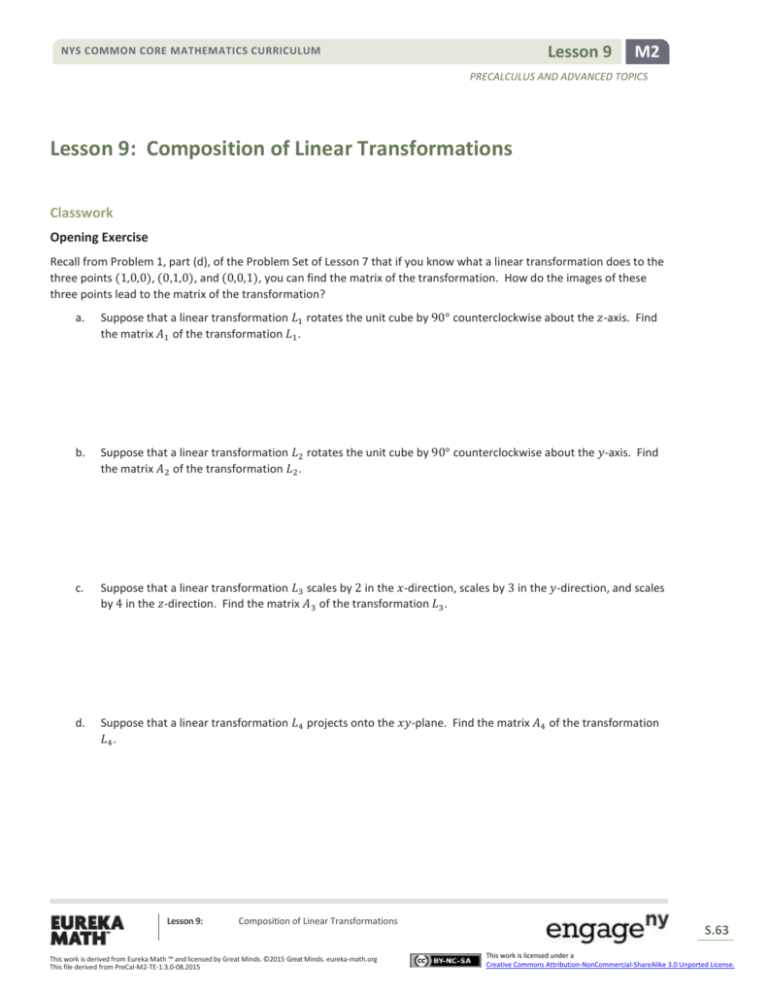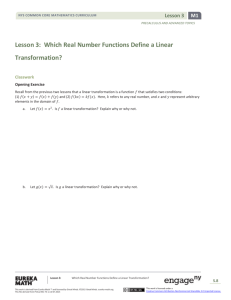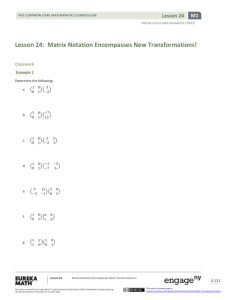Precalculus Module 2, Topic B, Lesson 9: Student
advertisement

Lesson 9 NYS COMMON CORE MATHEMATICS CURRICULUM M2 PRECALCULUS AND ADVANCED TOPICS Lesson 9: Composition of Linear Transformations Classwork Opening Exercise Recall from Problem 1, part (d), of the Problem Set of Lesson 7 that if you know what a linear transformation does to the three points (1,0,0), (0,1,0), and (0,0,1), you can find the matrix of the transformation. How do the images of these three points lead to the matrix of the transformation? a. Suppose that a linear transformation 𝐿1 rotates the unit cube by 90° counterclockwise about the 𝑧-axis. Find the matrix 𝐴1 of the transformation 𝐿1 . b. Suppose that a linear transformation 𝐿2 rotates the unit cube by 90° counterclockwise about the 𝑦-axis. Find the matrix 𝐴2 of the transformation 𝐿2 . c. Suppose that a linear transformation 𝐿3 scales by 2 in the 𝑥-direction, scales by 3 in the 𝑦-direction, and scales by 4 in the 𝑧-direction. Find the matrix 𝐴3 of the transformation 𝐿3 . d. Suppose that a linear transformation 𝐿4 projects onto the 𝑥𝑦-plane. Find the matrix 𝐴4 of the transformation 𝐿4 . Lesson 9: Composition of Linear Transformations This work is derived from Eureka Math ™ and licensed by Great Minds. ©2015 Great Minds. eureka-math.org This file derived from PreCal-M2-TE-1.3.0-08.2015 S.63 This work is licensed under a Creative Commons Attribution-NonCommercial-ShareAlike 3.0 Unported License. NYS COMMON CORE MATHEMATICS CURRICULUM Lesson 9 M2 PRECALCULUS AND ADVANCED TOPICS e. Suppose that a linear transformation 𝐿5 projects onto the 𝑥𝑧-plane. Find the matrix 𝐴5 of the transformation 𝐿5 . f. Suppose that a linear transformation 𝐿6 reflects across the plane with equation 𝑦 = 𝑥. Find the matrix 𝐴6 of the transformation 𝐿6 . g. h. 0 1 2 0 0 0 Suppose that a linear transformation 𝐿7 satisfies 𝐿7 ([0]) = [0], 𝐿7 ([1]) = [1], and 𝐿7 ([0]) = [0]. Find 1 0 0 0 0 1 2 the matrix 𝐴7 of the transformation 𝐿7 . What is the geometric effect of this transformation? 1 1 0 −1 0 0 Suppose that a linear transformation 𝐿8 satisfies 𝐿8 ([0]) = [1], 𝐿8 ([1]) = [ 1 ], and 𝐿8 ([0]) = [0]. Find 0 0 0 0 1 1 the matrix of the transformation 𝐿8 . What is the geometric effect of this transformation? Lesson 9: Composition of Linear Transformations This work is derived from Eureka Math ™ and licensed by Great Minds. ©2015 Great Minds. eureka-math.org This file derived from PreCal-M2-TE-1.3.0-08.2015 S.64 This work is licensed under a Creative Commons Attribution-NonCommercial-ShareAlike 3.0 Unported License. NYS COMMON CORE MATHEMATICS CURRICULUM Lesson 9 M2 PRECALCULUS AND ADVANCED TOPICS Exploratory Challenge 1 Transformations 𝐿1 –𝐿8 refer to the linear transformations from the Opening Exercise. For each pair: i. Make a conjecture to predict the geometric effect of performing the two transformations in the order specified. ii. Find the product of the corresponding matrices in the order that corresponds to the indicated order of composition. Remember that if we perform a transformation 𝐿𝐵 with matrix 𝐵 and then 𝐿𝐴 with matrix 𝐴, the matrix that corresponds to the composition 𝐿𝐴 ∘ 𝐿𝐵 is 𝐴𝐵. That is, 𝐿𝐵 is applied first, but matrix 𝐵 is written second. iii. Use the GeoGebra applet TransformCubes.ggb to draw the image of the unit cube under the transformation induced by the matrix product in part (ii). Was your conjecture in part (i) correct? a. Perform 𝐿6 and then 𝐿6 . b. Perform 𝐿1 and then 𝐿2 . Lesson 9: Composition of Linear Transformations This work is derived from Eureka Math ™ and licensed by Great Minds. ©2015 Great Minds. eureka-math.org This file derived from PreCal-M2-TE-1.3.0-08.2015 S.65 This work is licensed under a Creative Commons Attribution-NonCommercial-ShareAlike 3.0 Unported License. NYS COMMON CORE MATHEMATICS CURRICULUM Lesson 9 M2 PRECALCULUS AND ADVANCED TOPICS c. Perform 𝐿4 and then 𝐿5 . d. Perform 𝐿4 and then 𝐿3 . e. Perform 𝐿3 and then 𝐿7 . Lesson 9: Composition of Linear Transformations This work is derived from Eureka Math ™ and licensed by Great Minds. ©2015 Great Minds. eureka-math.org This file derived from PreCal-M2-TE-1.3.0-08.2015 S.66 This work is licensed under a Creative Commons Attribution-NonCommercial-ShareAlike 3.0 Unported License. NYS COMMON CORE MATHEMATICS CURRICULUM Lesson 9 M2 PRECALCULUS AND ADVANCED TOPICS f. Perform 𝐿8 and then 𝐿4 . g. Perform 𝐿4 and then 𝐿6 . h. Perform 𝐿2 and then 𝐿7 . Lesson 9: Composition of Linear Transformations This work is derived from Eureka Math ™ and licensed by Great Minds. ©2015 Great Minds. eureka-math.org This file derived from PreCal-M2-TE-1.3.0-08.2015 S.67 This work is licensed under a Creative Commons Attribution-NonCommercial-ShareAlike 3.0 Unported License. NYS COMMON CORE MATHEMATICS CURRICULUM Lesson 9 M2 PRECALCULUS AND ADVANCED TOPICS i. Perform 𝐿8 and then 𝐿8 . Exploratory Challenge 2 (Optional) Transformations 𝐿1 –𝐿8 refer to the transformations from the Opening Exercise. For each of the following pairs of matrices 𝐴 and 𝐵 below, compare the transformations 𝐿𝐴 ∘ 𝐿𝐵 and 𝐿𝐵 ∘ 𝐿𝐴 . a. 𝐿4 and 𝐿5 b. 𝐿2 and 𝐿5 Lesson 9: Composition of Linear Transformations This work is derived from Eureka Math ™ and licensed by Great Minds. ©2015 Great Minds. eureka-math.org This file derived from PreCal-M2-TE-1.3.0-08.2015 S.68 This work is licensed under a Creative Commons Attribution-NonCommercial-ShareAlike 3.0 Unported License. NYS COMMON CORE MATHEMATICS CURRICULUM Lesson 9 M2 PRECALCULUS AND ADVANCED TOPICS c. 𝐿3 and 𝐿7 d. 𝐿3 and 𝐿6 e. 𝐿7 and 𝐿1 f. What can you conclude about the order in which you compose two linear transformations? Lesson 9: Composition of Linear Transformations This work is derived from Eureka Math ™ and licensed by Great Minds. ©2015 Great Minds. eureka-math.org This file derived from PreCal-M2-TE-1.3.0-08.2015 S.69 This work is licensed under a Creative Commons Attribution-NonCommercial-ShareAlike 3.0 Unported License. NYS COMMON CORE MATHEMATICS CURRICULUM Lesson 9 M2 PRECALCULUS AND ADVANCED TOPICS Lesson Summary The linear transformation induced by a 3 × 3 matrix 𝐴𝐵 has the same geometric effect as the sequence of the linear transformation induced by the 3 × 3 matrix 𝐵 followed by the linear transformation induced by the 3 × 3 matrix 𝐴. That is, if matrices 𝐴 and 𝐵 induce linear transformations 𝐿𝐴 and 𝐿𝐵 in ℝ3 , respectively, then the linear 𝑥 𝑥 transformation 𝐿𝐴𝐵 induced by the matrix 𝐴𝐵 satisfies 𝐿𝐴𝐵 ([𝑦]) = 𝐿𝐴 (𝐿𝐵 ([𝑦])). 𝑧 𝑧 Problem Set 1. 1 Let 𝐴 be the matrix representing a dilation of , and let 𝐵 be the matrix representing a reflection across the 2 𝑦𝑧-plane. a. Write 𝐴 and 𝐵. b. Evaluate 𝐴𝐵. What does this matrix represent? −1 8 5 Let 𝑥 = [6], 𝑦 = [ 3 ], and 𝑧 = [−2]. Find (𝐴𝐵)𝑥, (𝐴𝐵)𝑦, and (𝐴𝐵)𝑧. 2 −4 4 c. 2. Let 𝐴 be the matrix representing a rotation of 30° about the 𝑥-axis, and let 𝐵 be the matrix representing a dilation of 5. a. Write 𝐴 and 𝐵. b. Evaluate 𝐴𝐵. What does this matrix represent? 1 0 0 Let 𝑥 = [0], 𝑦 = [1], 𝑧 = [0]. Find (𝐴𝐵)𝑥, (𝐴𝐵)𝑦, and (𝐴𝐵)𝑧. 0 0 1 c. 3. Let 𝐴 be the matrix representing a dilation of 3, and let 𝐵 be the matrix representing a reflection across the plane 𝑦 = 𝑥. a. Write 𝐴 and 𝐵. b. Evaluate 𝐴𝐵. What does this matrix represent? −2 Let 𝑥 = [ 7 ]. Find (𝐴𝐵)𝑥. 3 c. Lesson 9: Composition of Linear Transformations This work is derived from Eureka Math ™ and licensed by Great Minds. ©2015 Great Minds. eureka-math.org This file derived from PreCal-M2-TE-1.3.0-08.2015 S.70 This work is licensed under a Creative Commons Attribution-NonCommercial-ShareAlike 3.0 Unported License. NYS COMMON CORE MATHEMATICS CURRICULUM Lesson 9 M2 PRECALCULUS AND ADVANCED TOPICS 4. 3 0 0 0 −1 Let 𝐴 = [3 3 0], 𝐵 = [1 0 0 0 1 0 0 a. Evaluate 𝐴𝐵. −2 b. Let 𝑥 = [ 2 ]. Find (𝐴𝐵)𝑥. 5 c. Graph 𝑥 and (𝐴𝐵)𝑥. 1 3 5. 0 Let 𝐴 = 0 1 [2 0 a. b. c. 6. 8. 3 0 , 𝐵 = [1 1 0 3] 1 −3 0 0 0]. 1 Evaluate 𝐴𝐵. 0 Let 𝑥 = [3]. Find (𝐴𝐵)𝑥. 2 Graph 𝑥 and (𝐴𝐵)𝑥. 2 0 0 1 0 0 Let 𝐴 = [0 3 0] , 𝐵 = [0 1 0]. 0 0 8 0 0 0 a. Evaluate 𝐴𝐵. 1 b. Let 𝑥 = [−2]. Find (𝐴𝐵)𝑥. 4 c. Graph 𝑥 and (𝐴𝐵)𝑥. d. 7. 0 0 0]. 1 What does 𝐴𝐵 represent geometrically? Let 𝐴, 𝐵, 𝐶 be 3 × 3 matrices representing linear transformations. a. What does 𝐴(𝐵𝐶) represent? b. Will the pattern established in part (a) be true no matter how many matrices are multiplied on the left? c. Does (𝐴𝐵)𝐶 represent something different from 𝐴(𝐵𝐶)? Explain. 0 Let 𝐴𝐵 represent any composition of linear transformations in ℝ3 . What is the value of (𝐴𝐵)𝑥 where 𝑥 = [0]? 0 Lesson 9: Composition of Linear Transformations This work is derived from Eureka Math ™ and licensed by Great Minds. ©2015 Great Minds. eureka-math.org This file derived from PreCal-M2-TE-1.3.0-08.2015 S.71 This work is licensed under a Creative Commons Attribution-NonCommercial-ShareAlike 3.0 Unported License.








